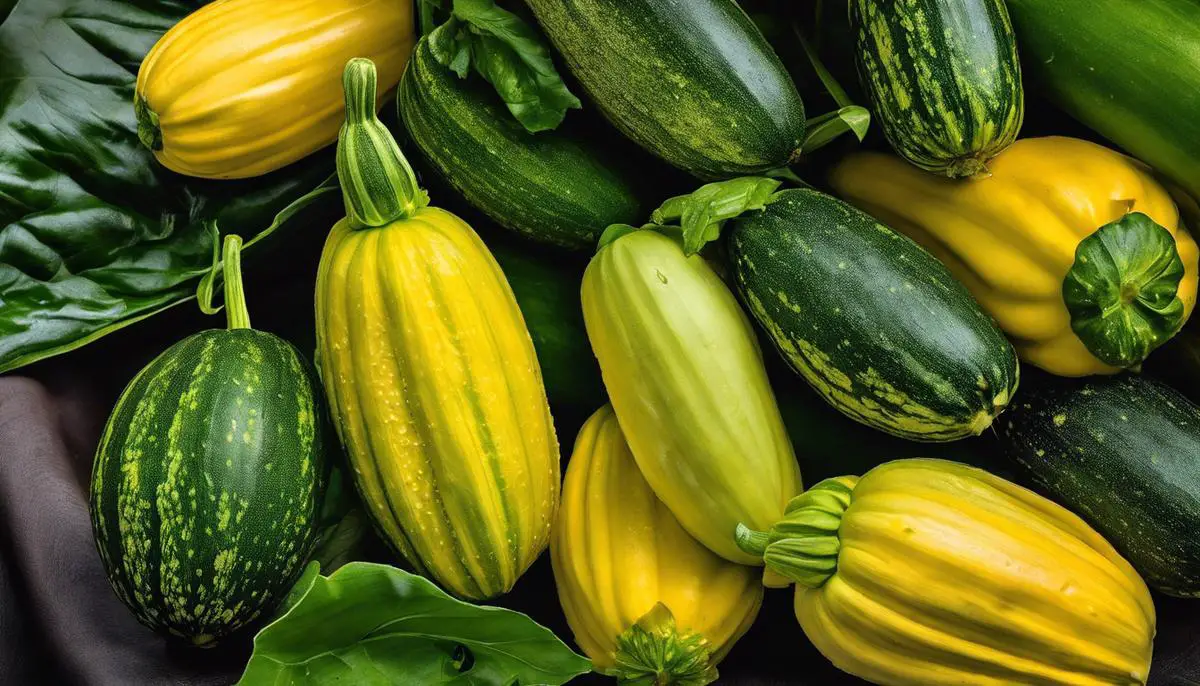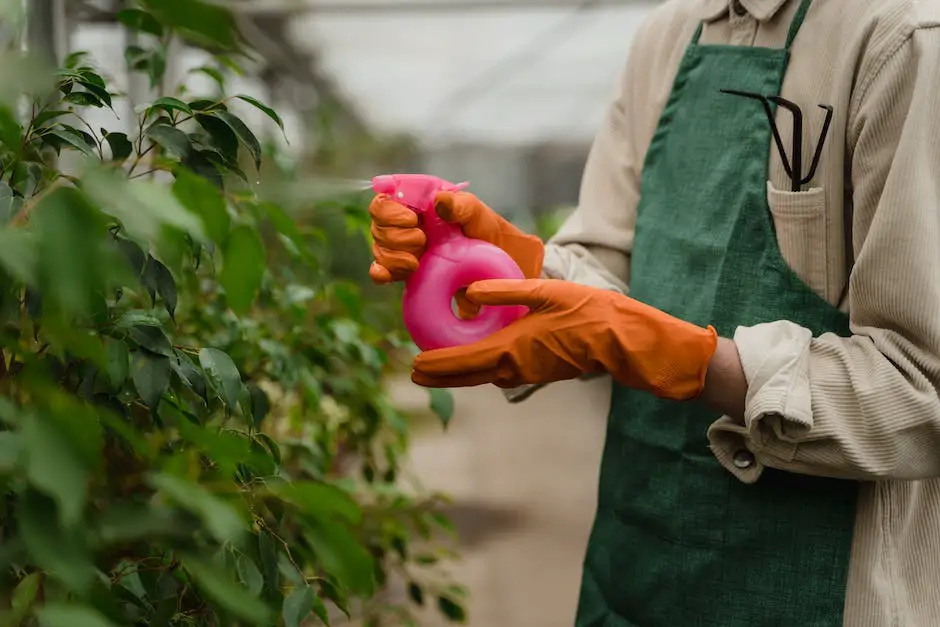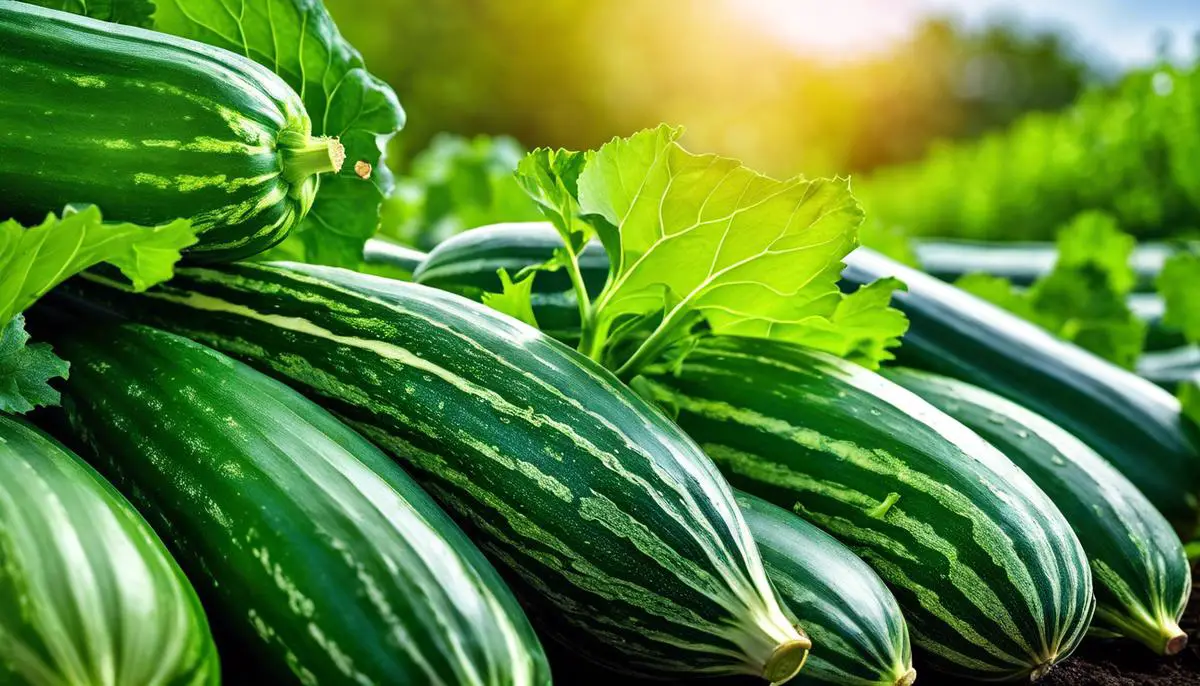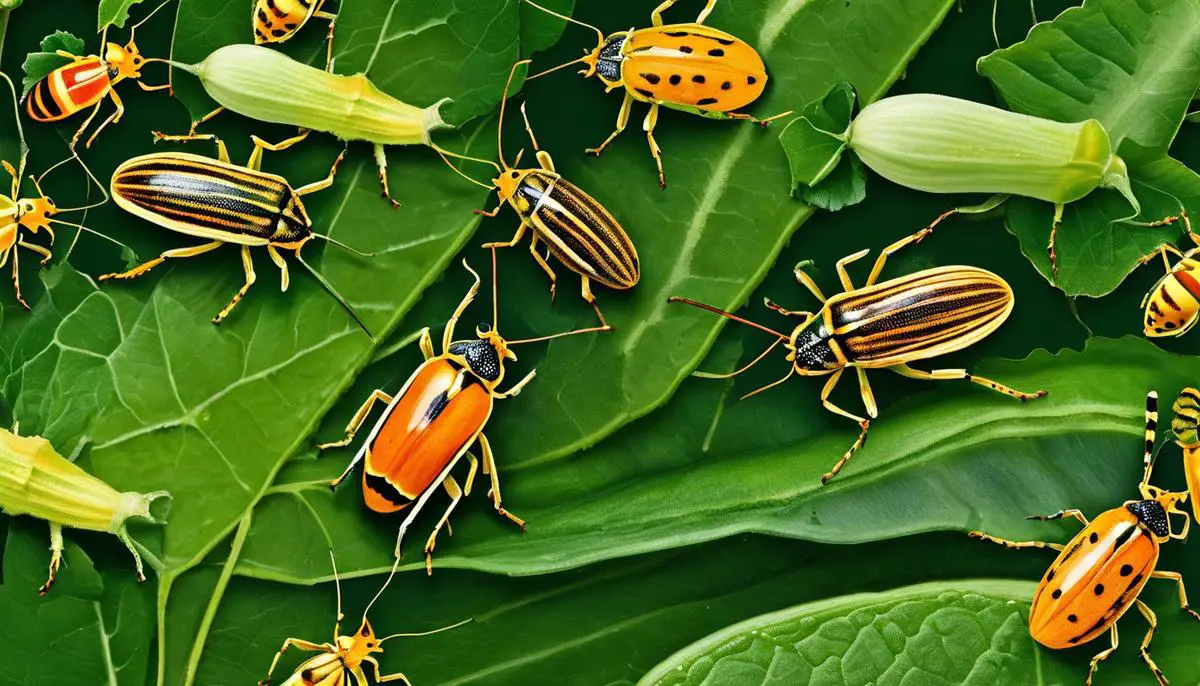Gardeners often regard zucchini as one of the most rewarding vegetables to grow due to its prolific nature and versatility in the kitchen. Yet, this squash is not without its challenges. Zucchini plants can fall prey to a cadre of pests and diseases that can dampen yields and dash hopes of a bountiful harvest. This guide aims to arm the home gardener with the necessary knowledge to identify and combat the common adversaries of zucchini plants. From the stealthy approach of squash bugs to the insidious infiltration of cucumber beetles and the devastating bore of vine borers, we will venture into the life cycles and identifying characteristics of these pests. Furthermore, we will take a magnifying glass to the diseases that can plague zucchini, such as the films of powdery and downy mildew and the dreaded wilt brought on by bacterial infection, providing insights into symptom identification, causes, and effective control measures. Armed with this information, gardeners can confidently approach the growing season, prepared to protect their zucchini plants from these all-too-common threats.
Identifying Common Zucchini Pests
The Mysterious Case of the Zucchini Munchers
Hey friends, let’s talk about something that can turn a gorgeous garden into a veggie crime scene – the mystery nibblers that target zucchini plants! You’ve put in the work, watched those seedlings sprout, and now something’s having a salad bar feast right in your backyard. Let’s dive into who the culprits could be and how to keep that zucchini bounty safe.
Reader Poll: What online courses would interest you?
First off, if it looks like someone took a chomp out of your zucchini leaves, chances are it’s a critter with an appetite for greens. We’re talking about pests here, the kind that enjoy your garden as much as you do – only they’re not asking for permission!
Common Zucchini Culprits:
- Cucumber Beetles: These yellow guys with black stripes or spots love to nibble. They’re tiny but mighty in the damage they cause. Look for them hanging out on leaves where they leave small round holes.
- Squash Bugs: Beware of these pests, which usually start on the underside of leaves. They can be tricky to spot, but you’ll know they’re there by the speckled appearance they leave behind.
- Squash Vine Borers: These pests are after more than just leaves; they go right for the stems, which can be devastating. The telltale sign is a sawdust-like frass near the base of the plants.
How to Keep Your Zucchini Safe:
- Keep It Clean: Removing debris and weeds regularly from the garden can reduce hiding spots for pests. A tidy garden means fewer places for bugs to settle in and make themselves at home.
- Barriers Are Your Friend: Use floating row covers to protect your young plants. This can keep those beetle bandits away until the flowers need to come for pollination.
- Natural Predators: Welcome toads, birds, and beneficial insects like ladybugs into your garden. They’re natural pest control agents who work for free!
- Hand Picking: Sometimes the old ways are the best ways. If you see pests, pluck them off. Get the kids involved – think of it as a backyard bug scavenger hunt (with gloves on, of course).
- Organic Pesticides: If things get out of hand, opt for organic pesticides as a last resort to protect your plants without adding harsh chemicals to your garden ecosystem.
Remember, a few nibbles here and there are normal, but with a little know-how, you can ensure those zucchini plants thrive and produce a bountiful crop. Happy gardening, everyone, and may your zucchini flourish! Keep those watchful eyes on the prize – delicious, homegrown zucchini for the win!

Managing Zucchini Diseases
Why Your Zucchinis are Looking Under the Weather: Beyond the Bugs
Subscribe to our newsletter!
When it comes to gardening, zucchinis can be one of the most rewarding – and sometimes frustrating – plants to grow. After tackling the common pest problems, what else could be causing those zucchini plants to look a little sad? Well, fellow green thumbs, it’s time to get down to the root of the issue—literally.
Water Woes: Too Much or Too Little?
Zucchinis, like all plants, need water—but it’s all about balance. If you’re seeing yellowing leaves or wilting plants, it might be time to assess your watering routine. Overwatering can lead to soggy soil and root rot, which is definitely not on any plant’s wish list. On the flip side, underwatering can stress out your zucchinis, leaving them struggling to soak up the nutrients they need. Aim for that sweet spot where the soil is moist but not waterlogged.
Feeding Time: Are Your Zucchinis Hungry?
Nutrients are to plants what a hearty meal is to a growing family—essential! If you haven’t thought about what’s on the menu for your zucchinis, they might be running on empty. A well-balanced fertilizer can work wonders. Look for one with plenty of nitrogen for leafy growth, phosphorus for strong roots, and potassium for overall health. Apply it according to your product’s instructions, and watch your garden family flourish.
Soil Secrets: Getting Down and Dirty
The secret to happy plants often lies in quality soil. Zucchinis are quite the fans of well-draining, fertile ground. If you’re working with hard clay or sandy soil, it’s like serving your plants a meal they can’t chew. Consider enriching your garden bed with compost to give your zucchinis a better foundation for growth. They’ll thank you with a bumper crop!
Spacing Out: Give Your Zucchinis Room to Breathe
Ever been to a crowded party and felt like you just couldn’t get enough air? Zucchinis understand that feeling all too well. Proper spacing is a must, as overcrowded plants can lead to inadequate airflow and increased competition for resources. Make sure your zucchinis have room to stretch out their leaves and grow without bumping elbows with their neighbors.
Sunshine Smiles: Are Your Plants Getting Enough Light?
Just like us, zucchinis love basking in the sunshine. These sun-worshippers need a good six to eight hours of light a day to thrive. If they’re planted in too much shade, it’s like spending all day indoors—they can become lethargic and produce less. Make sure your garden plot catches plenty of rays to keep your zucchinis energized and productive.
Disease Dilemmas: Is There an Uninvited Guest?
Diseases can sneak into the garden much like unwelcome guests at a family picnic. If you spot strange spots on leaves or stems, act fast. Some common diseases include powdery mildew and bacterial wilt, which are not just unpleasant to look at but can seriously affect your zucchini’s health. Keep an eye out, and at the first sign of trouble, remove affected areas or use recommended treatments to nip these problems in the bud.
Wrap it all up, and what do you get? Healthy, homegrown zucchinis require a little love, care, and know-how. With these additional insights, it’s time to turn sad zucchinis into the talk of the dinner table—because there’s nothing quite like the pride of serving up a dish grown in your own backyard garden. Happy gardening!

Natural Pest Control Strategies
Hey there, fellow green thumbs and nurturing nurturers! Ever gazed out at your garden, beaming with pride at those zucchinis just to find some uninvited guests have made a feast out of your hard work? Yikes. But before you reach for that chemical warfare, let’s talk about some nature-friendly ways to keep those pests at bay.
Your plants are like your family; you want to protect them without causing harm to others, right? Well, what if you could do just that by using ingredients often found in your very own kitchen? It sounds like a win-win situation!
For starters, consider concocting a homemade spray that pests will find super unappetizing. A simple mixture of water and a few drops of natural dish soap can turn leaves into a no-fly zone for those critters. Want to kick it up a notch? Add some cayenne pepper or garlic into the mix. Just remember, while these homemade sprays are safer than synthetic chemicals, they still need to be used judiciously to avoid affecting your plants or the good bugs that you want to stick around.
Next up, herbs and flowers aren’t just a treat for the eyes; they’re multitaskers that can help keep your zucchini company while fending off pests. Marigolds and nasturtiums are not just pretty; pests find them quite awful. Planting these around your vegetable garden is like setting up a security system that doubles as decor. Plus, they attract beneficial insects that actually help in pest control. It’s like having nature’s own pest management team!
And hey, let’s not forget about DIY traps. Boards or shingles placed on the soil overnight can lure in those sneaky squash bugs and cucumber beetles, who look for a cozy spot to rest. Come morning, simply lift them and remove the pests. Just make sure to relocate or dispose of them far from your precious zucchinis.
A dash of common sense also goes a long way. Rotate your crops regularly to outsmart those pests who may have set up camp waiting for your next round of zucchinis. Plus, diversity is key. By planting a variety of crops, you not only get a more vibrant garden but also reduce the chance of a full-on pest invasion focusing on one plant type.
In conclusion, keeping pests away naturally is all about balance, creativity, and working with nature rather than against it. Happy gardening, and may your zucchinis grow to be the envy of all—pests excluded, of course!

Preventative Measures for Zucchini Health
Now, let’s dive deeper into the world of zucchini plant care like we’re prepping for the best summer harvest block party on the block!
Ever see those powdery white spots on the leaves? Avoid the “oops” moment of realizing too late that powdery mildew has hit the zucchini plants! This common fungus loves some humidity and can make those leaves look like a dropped bag of flour. Tackle it head-on by mixing up a homemade milk spray – yes, milk! Mix one part milk with nine parts water and spritz it on the leaves. It’s kind of like that homemade mac ‘n’ cheese recipe – simple, effective, and a dash homely!
Don’t forget, healthy zucchinis start with the foundation – literally. We’re talking about the soil here. A soil test can be a gardener’s best friend. It’s like a sneak peek into what’s going on underground. If the soil is too acidic or too alkaline, it can mess with nutrient uptake. Adding amendments like lime or sulfur can help get that balance just right.
Ah, the drama of splitting zucchinis – veggies shouldn’t need a bandaid! Splitting usually happens from inconsistent watering. Those plants need hydration just like kids do after a day of running around in the sun. A soaker hose or a drip irrigation system can be a gamechanger, providing the constant hydration zucchinis crave without overdoing it. It’s like setting up a lemonade stand that never runs dry!
And let’s chat about supporting zucchini friendships – well, the plant version. Companion planting is like a garden mixer, where everyone brings something great to the table. Plant zucchinis near nasturtiums or marigolds, and it’s not just for a pop of color. These buddies help repel those tiny troublemakers that want to munch on your plants.
Last but not least, like any parent keeping an eye out for their youngster, it’s crucial to monitor zucchini plants for any signs of distress. Yellowing leaves can be a cry for help, potentially signaling a nutrient deficiency. Tend to those needs with a well-balanced fertilizer, and it’s like giving them a comforting hug and the nutrients they need to grow up strong.
So, fellow garden growers, it’s time to roll up those sleeves! Give those zucchinis some tender love and care, and they’ll be the belles of the summer harvest ball – or at least the talk of the neighborhood barbecue. Happy gardening!

The flourishing zucchini plant is a testament to the gardener’s vigilance and dedication to plant health. Through understanding the pests and diseases that threaten these humble squashes, and by employing strategies such as crop rotation, companion planting, and other natural deterrents, growers can create conditions that encourage robust growth and minimize distress. Regular monitoring, coupled with timely interventions, ensures that zucchini plants can thrive, providing the gardener with not only a sense of accomplishment but also the tangible reward of harvests that can be enjoyed in countless dishes. So let us nurture our gardens with an informed and attentive spirit, celebrating every zucchini that makes it from vine to table as a victory in the delightful challenge of plant care.

